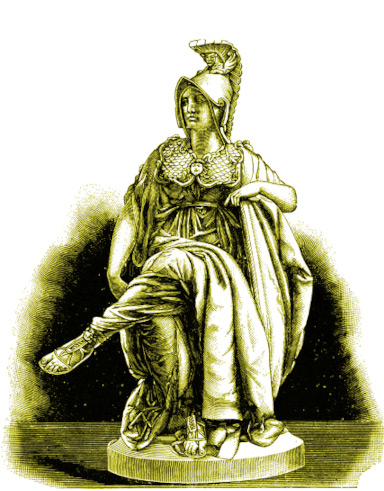
Minerva
Neith, Athena, Minerva.
Neith is one of the most ancient deities associated with ancient Egyptian culture
Athena is the Greek goddess of battle strategy, and wisdom, patron of Athens.
Minerva...
Minerva
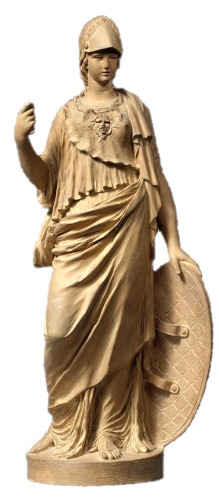 Minerva is the Roman goddess of wisdom. She was also the goddess of trade, the arts, and strategy in war. Her domains included medicine, poetry, and handicrafts as well. She was in charge of so many things that Ovid called her the “goddess of a thousand works”!
Minerva is the Roman goddess of wisdom. She was also the goddess of trade, the arts, and strategy in war. Her domains included medicine, poetry, and handicrafts as well. She was in charge of so many things that Ovid called her the “goddess of a thousand works”!
Minerva was highly influenced by the Greek goddess ATHENA. When the Romans made contact with the Greeks, they saw their gods as being similar to those of the Greeks. In fact, they decided that they were the same gods under different names.
She was often portrayed wearing a chiton, which is an ancient Greek garment, and a helmet. Many statues of her show her holding a spear and a shield, to represent her interest in war. But she can often be found offering an olive branch to the defeated. Minerva was a gracious winner in war, who had sympathy for those her armies beat.
Like Athena, Minerva's symbol is the owl, which today continues to represent wisdom. According to her myths, Minerva was born when her Jupiter, her father, swallowed her pregnant mother, Metis. He did this because of a prophecy that his child would one day defeat him.
Not one to remain idle, Metis forged weapons for the baby Minerva while inside Jupiter. Needless to say, the constant noise gave Jupiter a terrible headache and he asked the god, VULCAN, to hit his head with a hammer and split it open. (In some myths, Vulcan uses an axe.) Minerva emerged fully-grown from Jupiter’s forehead, armed with the weapons and clothed in the armor her mother had forged while inside Jupiter.
Another story about Minerva comes from Ovid’s book Metamorphosis. In this book, a young woman named Arachne brags about her weaving skills. She says that they’re even better than Minerva’s! Minerva, angry about this challenge, appeared to Arachne and challenged her to a weaving competition.
The subjects of their two tapestries were very different. Minerva, maybe with an eye to influencing any judges, wove a tapestry that featured herself beating all the other gods in a competition. Around the edges of the tapestry were figures of people who had challenged the gods and lost. Arachne, meanwhile, chose to depict the gods in various forms tricking humans.
Another famous contest in which Minerva, as Athena, won a contest against other gods. In the naming of the city of Athens, the gods had a contest to see who could create the most useful item for humans. Neptune made a horse, a very useful contribution for our ancient brethren. Minerva, however, created the olive tree. Olive oil remains very important to Mediterranean cultures, so important that to this day, in honor of that victory, Athens still bears Minerva's name.
Minerva had many titles because of her many roles. Some of these titles were:
Minerva Medica – patron of doctors
Minerva Castitis – patron of olive trees
Minerva Luscinia – a name that means 'nightingale', because she is said to have invented the flute
Minerva Armipotens – powerful in arms and the patron of strategy
Although she was equated with the Greek goddess Athena, Minerva was actually originally from the Etruscans, who were a people that lived in the same place as Romans did but before Rome existed. This ancient goddess was called Meneswa, which means "she who measures". This origin can be seen in one of Minerva’s other titles: Minerva Mensa, "Minerva who measures time".
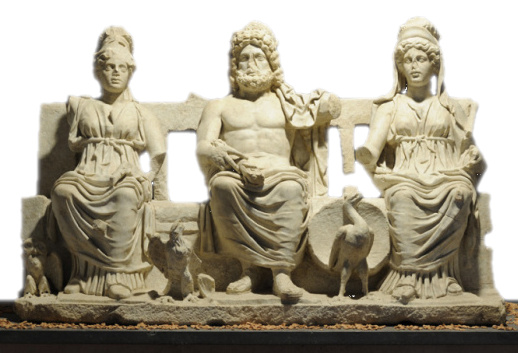 Minerva was very important to the Romans. As a matter of fact, she was part of the “Capitoline Trio”, which consisted of three gods that the Romans considered patrons of their city. The other two gods were Jupiter and Juno. These three gods were worshiped on the Capitoline Hill, which was a very important holy site in ancient Rome. As a matter of fact, that’s where we get the word “capitol,” as in Capitol Hill, from! So next time you think of Washington, D.C., you can think of Minerva.
Minerva was very important to the Romans. As a matter of fact, she was part of the “Capitoline Trio”, which consisted of three gods that the Romans considered patrons of their city. The other two gods were Jupiter and Juno. These three gods were worshiped on the Capitoline Hill, which was a very important holy site in ancient Rome. As a matter of fact, that’s where we get the word “capitol,” as in Capitol Hill, from! So next time you think of Washington, D.C., you can think of Minerva.
Minerva also was one of three “virgin goddesses” in Roman tradition. These three goddesses vowed to never marry, but rather dedicate themselves to their works. Vesta and DIANA were the other two in the trio.
Minerva was celebrated in a variety of festivals in ancient Rome. The most famous one may have been the Quinquatrus, which was dedicated to Minerva and MARS. It went from March 19-23. On the first day of this festival, no blood could be shed. However, the last day ended with gladiatorial battles. Women also consulted fortune-tellers, and there were speakers, poets, and plays being performed throughout the holiday.
Today, statues of Minerva can often be found in schools and libraries. Even though it has been thousands of years since the Romans actively worshiped her, Minerva continues to stand for wisdom and the act of creating things.
From the 2nd century BCE, Romans regarded her as equivalent with the Greek goddess Athena. In Britain, Minerva was conflated with the local wisdom goddess Sulis. Ancient Greeks identified Athena with the ancient Egyptian goddess Neith, the creatrix.
 There is a Romano-Celtic solid bronze votive in the form of the helmeted head of Minerva (1st century CE, 1.5″, 3.8 cm tall). Intensely stylized, she wears a high crested helmet decorated on either side with dolphins. Her hair falls in locks at the perimeter of her helmet. Her facial detail, including her wide eyes, broad nose and tightly closed lips, is strongly preserved. She wears an ornamental breastplate that ironically mirrors her own expression. This figure is an example of bronze votive Roman art as influenced by the native Celts of Britain. The eyes, and particularly the breastplate, are predominately Celtic in design.
There is a Romano-Celtic solid bronze votive in the form of the helmeted head of Minerva (1st century CE, 1.5″, 3.8 cm tall). Intensely stylized, she wears a high crested helmet decorated on either side with dolphins. Her hair falls in locks at the perimeter of her helmet. Her facial detail, including her wide eyes, broad nose and tightly closed lips, is strongly preserved. She wears an ornamental breastplate that ironically mirrors her own expression. This figure is an example of bronze votive Roman art as influenced by the native Celts of Britain. The eyes, and particularly the breastplate, are predominately Celtic in design.
One of the unique features of this example is the breastplate which mirrors the goddess' serious facial expression. Also, the sculpting of the helmet is zoomorphically styled with the dolphin heads. There are three similarly-sized bronze Minerva busts on display in the British Museum.
The Legend of Catumandus
The Greek colony, Massilia (now Marseilles) was founded in the early 6th century BCE near to what was to become the Celtic heartland. The Celts, as they developed, had generally good trading relationships with the Massalians with minor skirmishes won by the Massalians. However, in the early 1st century BCE, one Catumandus, meaning 'general' or ‘he who directs battle’ (cf. Irish cath and Welsh cad, battle), chieftain of the Saluvii centered on what in now Entremont, attacked Massilia. As reported by Pompeius Trogus, he saw ‘a vision of a menacing women who told him that she was a goddess' whom Catumandus took to be one of the Celtic triple goddesses of death and war (cf. the later Irish Morrigu, The Morrigan). She warned him against continuing the attack.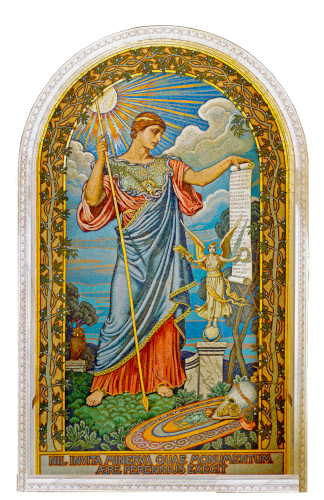
Catumandus broke off his attack, sued for peace with the Massialians and asked if he could enter the city and worship their gods:
According to Trogus, he recognized a statue of a goddess at the portico of the temple of Minerva and claimed it was the very woman he had seen in his vision. He therefore presented his gold torque, his necklace symbolizing his rank, as a sacrifice to the goddess and swore a treaty of perpetual friendship with the city.
Although Trogus reports this story, it certainly has the feel of legend or myth. It also suggests, however, that the Celts had encountered Minerva long before the Romans invaded the Celtic world and had probably incorporated here into their pantheon by whatever name.Athena
To the Greeks, Athena is the goddess of battle strategy, and wisdom. Identified by the Romans as the goddess Minerva, She was always accompanied by her owl and the goddess of victory, Nike. She is known for wearing her Aegis, a breastplate made out of goatskin, which was given to her by her father, Zeus.
Following the Greek myths around Athena, she was born of Metis, who had been swallowed by Jupiter, and burst from her father's head, fully armed and clad in armour.
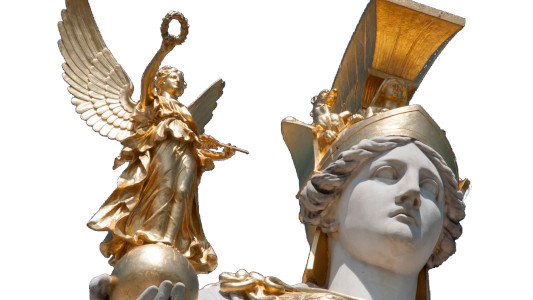 Athena of the Greeks is a goddess of wisdom, of household arts and crafts, of spinning and weaving, and of textiles. Athena is also inventor of the flute, the plough and the ox-yoke, the horse bridle and the chariot. Identified as Athena Nike (Victory) she is usually depicted with wings as the goddess of victory. Athena is not known to have a bellicose nature, nor does she bear arms except when her country is threatened or attacked. Then she fights well and helps or saves her champions too.
Athena of the Greeks is a goddess of wisdom, of household arts and crafts, of spinning and weaving, and of textiles. Athena is also inventor of the flute, the plough and the ox-yoke, the horse bridle and the chariot. Identified as Athena Nike (Victory) she is usually depicted with wings as the goddess of victory. Athena is not known to have a bellicose nature, nor does she bear arms except when her country is threatened or attacked. Then she fights well and helps or saves her champions too.
Perhaps most memorable for Her companion, the sacred owl, notice how owls and wisdom are still associated modern culture.
Those said to be of Minerva are people who "resonate" in the fields or on the wavelengths of Minerva, whether they be in the arts, civic development, certain kinds of music, literature, research, and (higher) study
The source of some of the material in this text was obtained from Minerva: https://greekgodsandgoddesses.net - Greek Gods & Goddesses, February 22, 2017